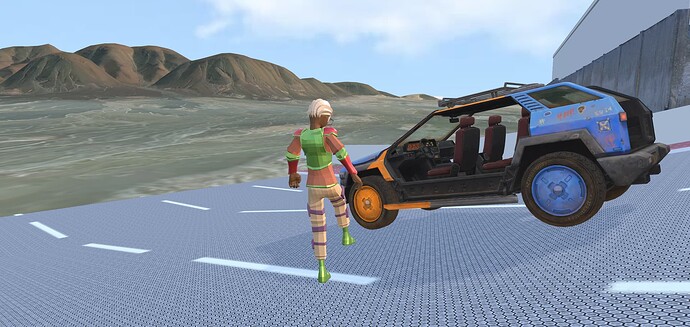This is a THREEjs+Cannon-ES virtual city.
This city is combination of ThreeJS + Cannon and clever 3d model design, ThreeJS + Cannon alone cannot make this work, the 3d model must also be built for the purpose. The 3d model must be built in a way that it should not be a network burden by compressing the textures and if not necessary for the scene reducing or even removing normal maps if the scene don’t make that much impression.
See Virtual City Model Design for ThreeJS + Cannon
Gameplay:
This source codes allows threejs designers and coders to build browser and mobile/android 3d virtual experience (metaverse) games quickly and easily.
Features:
This source code uses threejs and cannon library, the engine\assets\js*engine.js* is written to efficiently handle and manage city scale environment.
Download building assets
Download model components
Download game level
Download vehicle
Download avatar
Download buildings
Custom Avatar
To add characters, you can use your own Ready Player Me avatar url or create your own custom character, rig character at Mixamo, copy at engine/assets/models/players, and then register the character in the engine/assets/js/avatars.js JSON.
[{name:'avatarName', height: 1.8, weight: 97, offset: .12}]
avatar name: name of your avatar in fbx or glb file
avatar height: the avatar model height in meters
avatar weight: the avatar mass in kilograms
avatar offset: adjust the avatar offset from the floor, ensure the avatar feet touches the floor just right not floating and not sinking.
Custom Environment (City & Objects)
To replace city, you can use your own custom model in fbx or gltf format (texture embedded), copy the models to the engine/assets/models/objects folder and add the model file names in the engine/assets/js/levels.js JSON.
{name: 'modelName', type: 'modelType', loader: 'fileExtension', x: [0, 1], y: [0, 0], z: [0, 1], o:[{x:0,y:0,z:0},{x:0,y:90,z:0}], s:[1, 1], si:0, kg:[5, 5], sl:null, sh:'metalimpact', pc:'.5-1', px:1.2, ds:40}
model name: name of the fbx or glb file
model type: objectmesh, trimesh etc…
file extension: GLTF, GLB or FBX only
model positions: x:[0,1],y:[0,0],z:[0,1]
the model can clone in multiple positions for example x:[0,1] is placed in x axis 0 and x axis 1 or x:[0,1,2,3,4,5] is place in axis 0, 1, … and 5
model orientation: o:[{x:0,y:0,z:0},{x:0,y:90,z:0}]
model scale: s:[1, .5]
the model can cloned in different scale for instance a tree model example s:[1, .5] the first tree model clone is full scale (1) and the second tree model clone is half scale (.5)
model mass (kg): kg:[5,5]
the model can be of different mass in kilo grams for example kg:[0,1] the zero (0) is static and one (1) kilo gram is a kilogram or kg:[10,0,40,30,2] has different masses.
model proximity (meters): ds:40
What is 3D Browser Game [The Island City]?
Threejs release r155 updated
Checking release r155 updates if there will be bugs, error or conflicts?



























